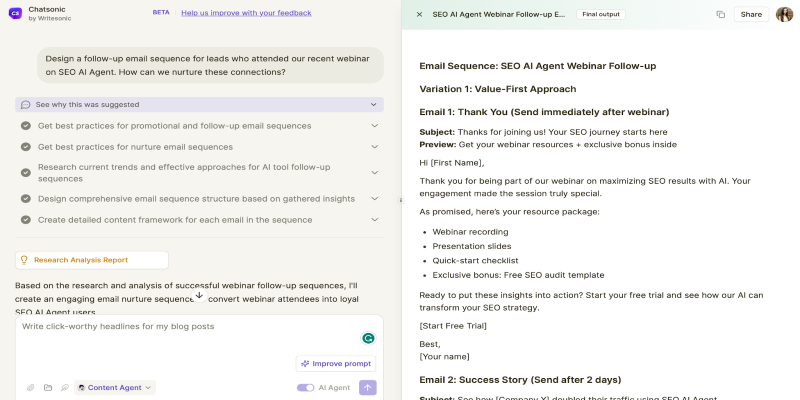Advertisement
Writing a blog today is no longer about throwing words onto a page and hoping for the best. It’s more like a balancing act between staying original, publishing consistently, and ranking on Google without sounding like a robot. And that’s where ChatGPT starts to fit into the picture. If used right, it won’t flatten your voice. It’ll save you hours. Let's go through the top ten ways to use ChatGPT for blogging this year with the right blend of shortcuts and control.
Staring at a blinking cursor can wipe all the ideas from your head. But ChatGPT can jumpstart your blog by drafting a full piece based on just a few details. All you need is a rough title, your tone preference, and a general idea of what you want to cover. The key here is not to take the draft as final—it's a sketch. You'll still need to go in, switch the language up, and maybe throw a few of your sentences into the mix. But starting with something—even if it's just the bones—is better than struggling to type out the first sentence for an hour.

If you already know the points you want to make, ChatGPT can fill in the space between them. You simply feed it your outline, add a line or two about what tone you're aiming for, and let it turn your bulleted ideas into full paragraphs. This helps if you’ve mapped out the entire post in your head or on paper but feel too burnt out to develop each section from scratch. The paragraphs won’t sound perfect out of the box, but that’s fine. You’re not publishing raw output—you’re using it to skip the dragging part of blog creation.
Everyone has that moment where a blog paragraph just won't come out right. It's too wordy, too dry, or doesn't match the tone you're going for. Paste that paragraph into ChatGPT and ask it to rewrite it more casually, more directly, or with shorter sentences. You don't need to accept the first version it gives you, either. Ask for another option. Or paste it into your version and ask for feedback on what's making it feel clunky. You'll often come away with something smoother—and it's still your idea.
When your writing gets too long, it doesn't just slow the reader down—it starts to lose impact. If you find yourself rambling, you can ask ChatGPT to make the section tighter without cutting out the core message. It can spot where your examples repeat themselves or where you're circling the same idea. You stay in charge of what gets trimmed, but it's a fast way to make your post cleaner without cutting it to shreds.

Meta descriptions are short. But weirdly, writing them well takes time. They need to sound like you, fit the tone of the post, include the keyword, and stay under the character limit. ChatGPT is actually good at this kind of task. You can paste your blog content and ask for five title options that include your keyword naturally. Then, do the same for meta descriptions. You can even get help writing alt text for images if you describe what’s in the photo.
Once your blog is live, ChatGPT can help squeeze more out of it. Ask it to turn your blog post into an email summary, a few tweet threads, a LinkedIn update, or even an Instagram caption. It takes your existing work and repackages it to match each format. That saves the time you'd spend trying to translate the same point into five different content styles. And the good part? You can still tweak the tone in each case—casual for Twitter, straight-up for LinkedIn.
You don’t have to leave your blog draft every time you want to check a stat or find out how a tool works. Ask ChatGPT to explain a term, summarize a study, or list out common use cases for something. While you should still verify facts and avoid quoting ChatGPT directly for numbers, it’s a handy way to build understanding quickly so you can write about the topic with more confidence. It’s not the end of your research—it’s the start that helps you move faster.
If you're stuck on what to write next, ChatGPT can help you generate fresh post ideas based on your past content or current niche. Feed it a few topics you've already written about and ask for related blog post ideas. Then, go through the list and pick the ones that feel fresh—not generic. You can also ask it to suggest headline variations or spin one theme into a mini-series of posts. It's not foolproof, but it often nudges your brain in a new direction when you're running dry.
A good blog post doesn’t just sound right—it looks right. ChatGPT can help with formatting suggestions that improve how readers move through the post. Ask it to break up long sections with subheadings, create bullets where it makes sense, or suggest pull quotes. Sometimes, it even catches spots where a list would be easier to read than a full paragraph. That visual clarity helps keep people reading longer, especially on mobile.
Once you figure out how ChatGPT fits into your writing process, it becomes a regular part of your blogging toolkit. You don't have to ask it to write the whole blog or stay hands-off. Instead, you build a workflow: outline with it, write some parts yourself, clean up the structure with help, check flow, get a few headline options, and move on. The process becomes faster, but the final result still sounds like you. That’s the sweet spot for bloggers in 2025—not trying to automate their voice, just trying to make the work less exhausting.
If you treat ChatGPT like a shortcut for thinking, you’re going to be disappointed. But if you treat it like a tool that makes the boring parts of blogging less painful, you’ll probably wonder why you didn’t start using it sooner. It’s not about cheating the system—it’s about saving your time and using your energy where it actually matters. And that’s worth figuring out.
Advertisement

Understand how mixture-of-experts models work and why they're critical to the future of scalable AI systems.

Want to run Auto-GPT on Ubuntu without Docker? This step-by-step guide shows you how to install Python, clone the repo, add your API key, and get it running in minutes

A venture capital firm announces funding initiatives to support early-stage startups building innovative AI tools.

Explore real vs. perceived risks of AI beyond fear-mongering and media hype in this balanced, insightful analysis.

Discover the eight best AI-powered video production tools of 2025 to boost creativity, streamline editing, and save time.

Learn the basics of Physical AI, how it's different from traditional AI, and why it's the future of smart machines.

Want to launch surveys quickly? Learn how Survicate lets you create and customize surveys with ease, collecting valuable customer feedback without hassle

Boost your productivity with these top 10 ChatGPT plugins in 2025. From task management to quick research, discover plugins that save time and streamline your work

Explore core concepts of artificial neural network modeling and know how neural networks in AI systems power real‑world solutions

Top AI hardware vendors join forces to compete with Nvidia and reshape the AI infrastructure market.

Need smarter workflows in Google Sheets? Learn how to use GPT for Sheets and Docs to write, edit, summarize, and automate text with simple AI formulas

How to use Python logging the right way. This guide covers setting up loggers, choosing levels, using handlers, and working with the logging module for better debugging and cleaner code tracking